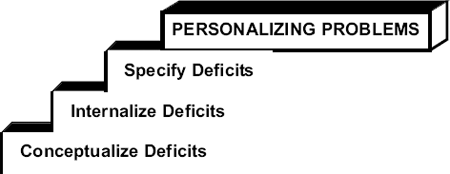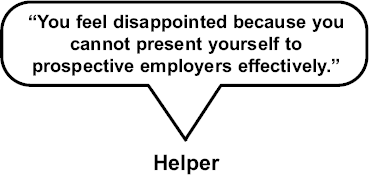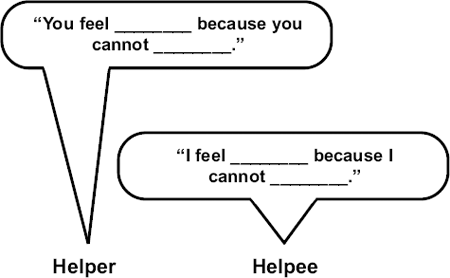Personalizing problems is the most critical transitional step to action. It is from defining problems in new ways that we derive new goals. It is from new goals that we derive new action programs.
By personalizing meaning, the helpees have begun to understand their situation in terms of its internal, rather than external, significance. The helpees, however, have still not grappled with their behaviors and how they may be contributing to the situation.
When we personalize problems, we help them to understand what it is that they are unable to do that has led to their present experience of themselves. In other words, we answer the question: “What is there about the helpees them selves that is contributing to the problems?” We are asking the helpees to take responsibility for their lives and to look at themselves as the source of their problems. Personalizing problems involves conceptualizing, internalizing and specifying deficits.

PERSONALIZING PROBLEMS
When conceptualizing deficits, we ask these questions of ourselves: “What is missing that is contributing to the problem?” and “What is it that the helpee is failing to do that is contributing most directly to this problem?” We are attempting to ascertain the missing ingredient that might be contributing to the problem. Sometimes we are initially unaware of what that ingredient might be. We must search our own experiences and our own understanding of human health and development. We may have to search out expert information and people for advice.
For example, in a review of physical, emotional and intellectual ingredients for human health and development, we may find the helpees deficit in skills, knowledge or attitude in any of these areas:
• Physical energy
• Motivation
• Interpersonal relating
• Specific information
• Learning
• Thinking or processing
When helpees are unable to conceptualize their own deficits, it is the helper who will conceptualize the helpees’ deficits. We may conceptualize the deficit by thinking in terms of the format: “ (deficit) is missing.”

To assist the helpees in internalizing their deficits, we will formulate responses that communicate the helpees’ accountability or responsibility for their deficits. Our “additive” personalized responses will assist the helpees to understand their roles in their problems. Our personalized responses will answer the helpee’s internalizing question: “What is there about me that is contributing to the problem?”
We may formulate our personalized responses to the problem by thinking in terms of the format: “You feel ________ because you cannot (problem/deficit).”

INTERNALIZING DEFICITS
Finally, it is important to specify the deficit. If we can specify the deficit, then we will be able to specify the goal and, therefore, make it achievable. The helpee’s problem or deficit can be described as a behavior or series of behaviors. Use the format: “You feel ________ because you cannot (problem/deficit).”

SPECIFYING DEFICITS
We need to stay tuned to the new feelings attendant to the personalized problem. Personalizing feeling emphasizes responding to how the helpees feel about themselves in relation to their deficits. When helpees internalize a deficit, their feelings about themselves and their experiences will often change. We continue to ask the empathy question: “If I were the helpee, how would I feel?” For example, feelings of disappointment—the most common helpee feeling about deficits—may become feelings of weakness or vulnerability because the helpees lack responses to handle their situations.

PERSONALIZING CHANGING FEELINGS ABOUT DEFICITS
The helpees inform us of their readiness to move from discussing their problems to discussing their goals. They alert us by demonstrating their ability to formulate and communicate their understanding of their problems or deficits. In other words, the helpees inform us by doing for themselves the things that we have been doing for them.

HELPEES SIGNAL THEIR READINESS TO BEGIN UNDERSTANDING GOALS
